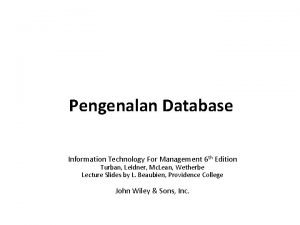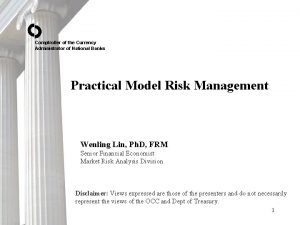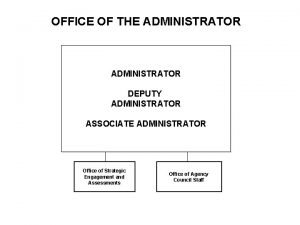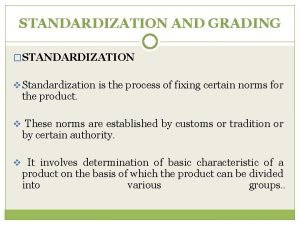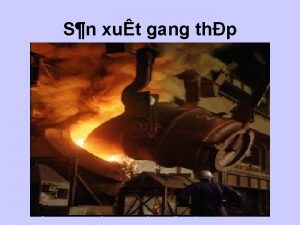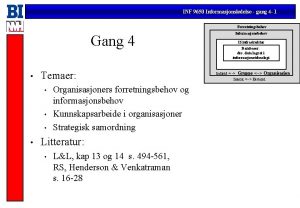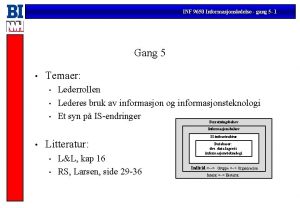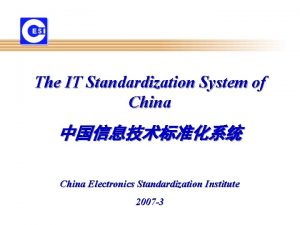Standardization in China Mr Chen Gang Administrator Standardization
















- Slides: 16

Standardization in China Mr. Chen Gang Administrator Standardization Administration of the People’s Republic of China 1

Contents I. Overview of Chinese Standardization II. Alignment with International Standards 2

I. Overview of Chinese Standardization 1. Chinese National Standards Body 2. Standardization Management in China 3. Overview of Chinese Standardization 3

1. Chinese National Standards Body National level: Authorized by the State council, the Standardization Administration of China (SAC) exercises the unified management of standardization at national level, and represents China to participate the activities of ISO, IEC and other international and regional standardization organizations 4

1. Chinese National Standards Body Provincial level: Local competent authority (namely Quality and Technical Supervision Bureau) is responsible for the standardization within their own regions, including planning, approval, numbering, promulgation and registration of standards.

1. Chinese National Standards Body National SAC’s main responsibilities include: - developing the legislations on standardization. - establishing the strategy objectives of standardization in China;coordinating on the development and revision of national standards. - adopting national standards. 6

1. Chinese National Standards Body - working closely with national standard technical committees to follow up the scientific& technical progress related to standardization. - coordinating and registration of sector and local standards. - supervising the implementation of national standards. - managing national information system on standardization. - representing China to join the ISO, IEC and other international and regional standardization organizations; signing and implementing the international cooperation agreement on standardization. 7

2、Standardization Management in China SAC Provinces and Local regions Ministries and Industries National Institute of Standardisation Associations 497 Technical Committees of Standardization Administration of China

3. Overview of Chinese Standardization Since the establishment of SAC in 2001, Chinese standardization work has got great development: n The standardization work is supported by government, led by market, coordinated by industries, colleges, and institutes, and participated by market sectors and all related stakeholders. n National standards system is basically formed, and a series of important standards in the areas of food safety, consumer products safety, industrial adjustment and revitalization, highnew technology, resources and energy efficiency, 9 environmental protection are developed.

II. Alignment with International Standards Chinese government pays high importance to the adoption of international standards, from the evidences of: (1) When the proposals of national standards are submitted to SAC, those intending to adopt international standards will have priority to approve, (2) Researching programs on the comparison with the international adoption will be given financial support, and (3) Updating of national standard due to the revision of international standards will be through fast procedure. 10

The adoption rate exceeds 80% in the areas of iron and steel, electromechanical equipment, shipping, instruments and meters. The adoption rate reaches 98. 5% in 12 areas including the electrical wire and cable, capacitive component, measuring devices. 11

The fact proves that adoption of international standards has improved the products quality, enhanced the production process, and played very important role in ensuring the human health, personal safety and safety of property, protecting animal and plants life and health, as well as protecting environment. It will help Chinese products to avoid the unnecessary technical barriers to international trade. 12

challenges The participation in international standardization activities is still at low level, which influences the alignment with international standards. Since the ability of our experts participating in international standardization is not so strong, we cannot follow the development of international standards very closely. This has influenced our adoption of international standards in time. 13

4. Future Work (1) Continue to make the adoption of international standards as our important technical and economic policy. Further improve this work and promote the alignment with the international standards. (2) Actively participate in international standardization activities, so that we could follow the updated development of international standards. This will help us to adopt international standards in time. 14

4. Future Work (3) Strengthen the cooperation and communication with international and European standardization organizations. Due to the influence of European countries in the development and revision of international standards, Chinese experts are quite willing to participate in European standardization activities, so as to get the updated information about the European standards and also the international standards, and finally promote the alignment between the national and international standards. 15

Thanks! Mr. Feng Chunguang Third Secretary of Chinese Mission to the EU fengcg@aqsiq. gov. cn 16
 Chen chen berlin
Chen chen berlin Erp for hospitals
Erp for hospitals Database administrator
Database administrator School business administrator licensing
School business administrator licensing Assessform edu au
Assessform edu au Brugeradministration emu
Brugeradministration emu Free gmetrix access codes
Free gmetrix access codes Jill hanley
Jill hanley Contract administrator training
Contract administrator training Ec-council network security administrator
Ec-council network security administrator Administrator bezpieczeństwa informacji szkolenie
Administrator bezpieczeństwa informacji szkolenie Comptroller of the currency administrator of national banks
Comptroller of the currency administrator of national banks Ability profiler
Ability profiler Nemrefusion virk
Nemrefusion virk Kaseya virtual system administrator
Kaseya virtual system administrator Nc test admin
Nc test admin Assessform.edu.au naplan
Assessform.edu.au naplan


